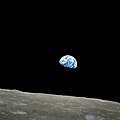العربية: التُقطت هذه الصُورة من قِبل أحد أعضاء طاقم
أپولو 8 المدعو
بيل آندرس يوم 24 كانون الأوَّل (ديسمبر) سنة 1968، بِتوقيت المُهمَّة 075:49:07
[1] (16:40 ت ع م)، بينما كان الطاقم يدور في مدار القمر، وهي تُظهرُ شُرُوق الأرض لِلمرَّة الثالثة فوق أُفق القمر. يبعد الأُفق القمري كيلومترًا عن المركبة الفضائيَّة. يبلغ عرض المنطقة المُصوَّرة عند الأُفق الأخير حوالي 175 كيلومترًا.
[2] اليابسة الظاهرة فوق خط الأُفق بِقليل هي أفريقيا الغربيَّة.
لاحظ أنَّ هذه الظاهرة مرئيَّة فقط لِلناظر المُتحرِّك بِالنسبة لِسطح القمر. بِسبب دوران القمر المُتزامن مع دوران الأرض (أي أنَّ وجه القمر المُوجه لِلأرض يبقى هو نفسه)، فإنَّ الأرض تبدو وكأنها ثابتة (تُقاسُ بِأيِّ وحدةٍ أقل من الوحدة الزمنيَّة الجيولوجيَّة) في «سماء» القمر. في سبيل مُشاهدة تأثير شُرُوق وغُروب الأرض خلف أُفق القمر، على الناظر أن يتوجَّه نحو، أو يبتعد عن، نُقطة سطح القمر التي تعلوها الأرض مُباشرةً (في وسط السماء). وإلَّا، فإنَّ الحركة الظاهريَّة لِلأرض ومنظرها المرئيّ سيتبدَّل ويقتصر على: 1. ازدياد أو تناقص حجمها باختلاف المسافة الفلكيَّة بين الجرمين السماويين. 2. الحركة الظاهريَّة البسيطة لِلأرض بِسبب الشُذوذ المداري لِلقمر، يُسمَّى هذا التأثير
ميسانًا. 3. دوران الأرض (دورانُ القمر مُتزامنٌ مع دوران الأرض، أمَّا دوران الأرض
فليس مُتزامنًا مع دوران القمر). 4. التغيُّرات الجويَّة والسطحيَّة على الأرض (مثلًا: الأنماط المُناخيَّة، المواسم المُتعاقبة، إلخ.).
Беларуская (тарашкевіца): Фатаздымак, зроблены астранаўтам «Апалёну-8» Білам Андэрзам ранкам 24 сьнежня 1968 року а 075:49:07 з пачатку палёту
[3] (16:40 UTC), на арбіце вакол Месяца, паказвае трэці ўзыход Зямлі над месячным гарызонтам. Месячны гарызонт знаходзіцца прыкладна за 780 км ад касьмічнага карабля. Шырыня сфатаграфаванага абшару на месячным гарызонце — каля 175 км
[4]. Кавалак зямлі, бачны адразу над лініяй сьветападзелу — заходняя Афрыка.
Зьвярніце ўвагу, што такі эфэкт бачны толькі такому назіральніку, які знаходзіцца ў руху адносна паверхні Месяцу, бо Месяц круціцца сынхронна адносна Зямлі (Месяц заўсёды павернуты да Зямлі адным бокам), і з-за гэтага Зямля на месячным «небе» падаецца нерухомай (ня ўлічваючы часавага прасьцягу геалягічных маштабаў). Каб убачыць эфэкт узыходу ці заходу Зямлі над месячным гарызонтам, назіральнік мусіць перамясьціцца ўперад ці ўзад ад кропкі на паверхні Месяцу, дзе Зямля знаходзіцца над самай галавой (па цэнтры неба). Іначай бачны рух/зьмена становішча Зямлі будзе абмежаваная: 1. Павелічэньнем/памяншэньнем памеру пры зьмяненьні адлегласьці між двума нябёснымі целамі. 2. Драбнюткім заўважным зьмяшчэньнем Зямлі з прычыны эксцэнтрысытэту арбіты Месяцу — эфэкту пад назвай «хістаньне». 3. Кручэньнем Зямлі (кручэньне Месяцу сынхроннае адносна Зямлі, а кручэньне Зямлі не сынхроннае адносна Месяцу). 4. Атмасфэрным і паверхневым зьмяненьнямі на Зямлі (напрыклад: мадэлямі надвор’я, зьмяненьнем пораў году й інш.). Двум кратэрам, бачным на здымку, Міжнародны астранамічны зьвяз у 2018 року прысвоіў найменьні 8 Homeward і Anders' Earthrise у гонар місіі «Апалёну-8»
[5].
Čeština: Fotografie z povrchu Měsíce zdánlivě zapadající Země byla pořízená členem posádky
Apolla 8 Billem Andersem 24. prosince 1968.
cv
Udah bumi bumi udah selesai di bulan 🌒🌙 pl
Ελληνικά: Τραβηγμένη απο τον Μπιλ 'Αντερς, μέλος του πληρώματος του διαστημοπλοίου
Απόλλων 8 στις 24 Δεκεμβρίου, 1968 στις 075:49:07 ώρα αποστολή
[6] (16:40 UTC) εν'όσω βρίσκονται σε τροχιά γύρω απο την Σελήνη, παρουσιάζει την Γη να ανατέλει για τρίτη φορά στον Σεληνιακό ορίζοντα. Ο Σεληνιακός ορίζοντας βρίσκεται περίπου 780 χιλιόμετρα μακρία απο το διαστημόπλοιο. Το ύψος της φωτογράφημένης περιοχής του σεληνιακού ορίζοντα είναι περίπου 175 χιλιόμετρα.
[7]. Η μάζα γης που είναι ορατή πάνω ακριβώς απο την τελική γραμμή ειναι η δυτική Αφρική.
Να σημειωθεί πως αυτό το φαινόμενο ειναι ορατό απο έναν παρατηρητή μόνο σε σχετική κίνηση με την επιφάνεια της Σελήνης. Εξαιτίας της συγχρονισμένης Σεληνιακής περιστροφής σχετικά με την Γη (πχ, η ίδια πλευρά της Σελήνης είναι πάντα ορατή στην Γη), η Γη φαίνεται σαν να είναι στατική στον σεληνιακό ουρανό.
English: Taken by
Apollo 8 crewmember
Bill Anders on December 24, 1968, at mission time 075:49:07
[8] (16:40 UTC), while in orbit around the Moon, showing the Earth rising for the third time above the lunar horizon. The lunar horizon is approximately 780 kilometers from the spacecraft. Width of the photographed area at the lunar horizon is about 175 kilometers.
[9] The land mass visible just above the terminator line is west Africa.
Note that this phenomenon is only visible to an observer in motion relative to the lunar surface. Because of the Moon's synchronous rotation relative to the Earth (i.e., the same side of the Moon is always facing Earth), the Earth appears to be stationary (measured in anything less than a geological timescale) in the lunar "sky". In order to observe the effect of Earth rising or setting over the Moon's horizon, an observer must travel towards or away from the point on the lunar surface where the Earth is most directly overhead (centred in the sky). Otherwise, the Earth's apparent motion/visible change will be limited to: 1. Growing larger/smaller as the orbital distance between the two bodies changes. 2. Slight apparent movement of the Earth due to the eccenticity of the Moon's orbit, the effect being called
libration. 3. Rotation of the Earth (the Moon's rotation is synchronous relative to the Earth, the Earth's rotation is
not synchronous relative to the Moon). 4. Atmospheric & surface changes on Earth (i.e.: weather patterns, changing seasons, etc.). Two craters, visible on the image were named
8 Homeward and
Anders' Earthrise in honor of Apollo 8 by IAU in 2018. (
Press release). The NASA image number is AS08-14-2383.
Español: "Amanecer de la Tierra" desde la luna. Foto tomada el 24 de diciembre de 1968 por Bill Anders, que muestra la tierra que parece elevarse detrás del horizonte lunar. Este fenómeno es visible solo por alguien que orbita el astro. Debido a la rotación sincrónica de la luna, que siempre muestra la misma cara hacia la tierra, no vemos que la tierra se eleve o se extienda desde la superficie de la luna.
Français : "Lever de terre" sur la lune. Photo prise le 24 décembre 1968 par Bill Anders, et montrant la terre semblant se lever derrière l'horizon lunaire. Ce phénomène n'est visible que par quelqu'un en orbite autour de l'astre. A cause de la rotation synchrone de la lune, qui montre toujours la même face vers la terre, on ne voit pas la terre se lever ou se coucher depuis la surface de la lune.
Magyar: „Földfelkelte” a Holdról 1968. december 24-én,
Bill Anders, az
Apollo 8 űrhajósának képén. Valódi „földfelkeltét” csak az láthat, aki kering a Hold körül, mert a Hold egy adott pontjáról nézve a Föld az égnek folyamatosan ugyanazon a részén látszik (megfordítva: a Földről a Holdnak mindig és mindenhol (megközelítőleg) ugyanaz a fele látszik). A Föld forgása, illetve a napfényes részének változása viszont a Hold felszínéről is látszik.
Русский: Фото, полученное
Уильямом Андерсом, пилотом корабля «
Аполлон-8» 24 декабря, 1968, показана видимая часть Земли, поднимающаяся над лунной поверхностью. Заметим, что это явление видимо только на некоторых орбитах Луны. Из-за синхронного вращения Луны вокруг Земли (т.е. та же сторона Луны всегда обращена к Земле), восход Земли над линией горизонта (Earthrise) нельзя наблюдать ни в какой точке Луны.





















